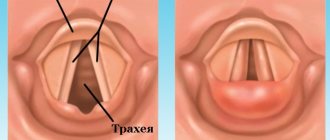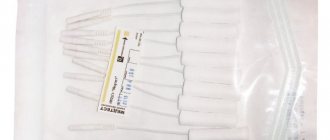Kinds
There are several types of pathological condition. The main classification divides the disease into acute and chronic. In the first case, symptoms of inflammation develop immediately after suffering from respiratory or viral diseases. In this case, the manifestations greatly worsen the patient’s quality of life and his condition.
In the chronic form, the symptoms are not so pronounced and occur after suffering an acute form of inflammation or improper treatment. In most cases, the disease results from non-compliance with recommendations during the treatment of acute inflammation of the Eustachian tube. As a rule, this classification is used to separate types of pathology in adults.
In children, inflammation can be bilateral or unilateral. In the first case, the pathology occurs in a very severe form, often provokes complications and can progress to the chronic stage. With unilateral inflammation, the symptoms affect only one ear, the disease is easier to treat and less likely to provoke complications.
In addition, there are 3 types of pathology, taking into account the type of inflammatory process. However, they can develop in adults and children.
| Type of inflammation | Peculiarities |
| Catarrhal | This species is considered the least dangerous if treated promptly. It develops after a viral disease, when the pressure in the tympanic cavity decreases, which leads to the penetration of fluid into it, which forms in the nasopharynx. As a result, this fluid is released from the ear, but it does not contain pathogens |
| Serous | This form of pathology is also called exudative. In this case, the disease most often becomes the result of the lack of treatment for the catarrhal form of the pathological process. With the constant accumulation of fluid in the eustachian tube, pathogenic bacteria multiply in it, which provoke aggravation of clinical manifestations, as well as the spread of inflammation to other tissues |
| Purulent | The most dangerous form of pathology, in which pus forms in the Eustachian tube and pathogenic microorganisms quickly multiply. The tissues become swollen, inflammation quickly spreads to other parts of the hearing aid, leading to complications |
Each type of disease can progress to a more severe form, but clinical manifestations may vary among patients.
Causes of the disease
The main pathological conditions that can cause acute or chronic tubular dysfunction are:
- diseases of the respiratory tract, accompanied by a runny nose and swelling of the nose (flu, colds, etc.);
- chronic and acute diseases of the nose and paranasal sinuses (sinusitis, adenoiditis, chronic rhinitis, polypous degeneration of the mucous membrane, etc.);
- anatomical nuances in the structure of the nasal cavity (curved nasal septum, enlargement and shape of the nasal turbinates, etc.);
- tumor processes in the nasopharynx.
Separate forms of bilateral tubootitis are aerootitis (occurs due to pressure changes during takeoff and descent of an aircraft) and mareotitis (during the diving and ascent of scuba divers).
Tubootitis often develops against the background of acute respiratory viral infections
Stages and degrees
Tubootitis (symptoms and treatment in children and adults should only be discussed with a specialist) occurs in 3 stages, which does not depend on the type of inflammation. The only difference is that in the acute form, one stage passes into another faster, and the symptoms appear more pronounced. In addition, the advanced stage of catarrhal and purulent inflammation is somewhat different in severity.
The initial stage is accompanied by minor hearing impairments. As a rule, children react to this more pronouncedly, talking about discomfort and ear congestion, as well as other manifestations. Adults may not pay attention to the first manifestations, considering them a sign of a cold.
At a progressive stage, it is already possible to identify the form of pathology, which is determined depending on the patient’s sensations, as well as the nature of the discharge from the ear. All symptoms worsen, the patient’s general condition is disrupted, and there is a significant increase in body temperature. It is at this stage that the patient usually consults a doctor.
It is worth noting that children endure the progressive stage of the disease more difficultly than adults; their body temperature rises to critical levels, and the pain is much stronger.
At an advanced stage, all symptoms worsen, and complications from the nasopharynx are added. The child’s condition at this stage is serious; adults also adhere to bed rest.
Treatment for this degree of disease is quite lengthy and complex, since it is necessary not only to eliminate the inflammation of the tube, but also the complications that arose as a result of the lack of timely therapy.
Symptoms of the chronic form of the disease
The symptoms of chronic tubo-otitis are in many ways similar to those of acute tubo-otitis. Observed:
- clouding of the eardrum;
- redness in the inner ear;
- increased body temperature;
- sometimes severe pain in the ear.
A characteristic sign is deformation of the eardrum and narrowing of the auditory tube , accompanied by persistent impairment of auditory activity. The described symptoms are permanent.
Chronic tubo-otitis occurs periodically. Often the first symptoms of the disease are similar to the manifestations of acute respiratory viral infections and acute respiratory infections.
Tinnitus and congestion, characteristic of the acute form of the disease, appear exclusively when pressure drops occur during severe coughing, sneezing and during takeoff or landing of an airplane, or diving under water.
The disease is especially dangerous for children , whose ear canal is somewhat shorter than that of adults. Actually, this determines the predisposition of children to various types of ear diseases.
Reference. In adults, tubo-otitis is most often unilateral, but in children, bilateral tubo-otitis often occurs, the chronic form of which is very unpleasant.
Symptoms
The first sign of tubal inflammation is considered to be tinnitus, as well as significant hearing loss, which worsens the patient’s quality of life. In this case, the symptoms are the same for adults and children, but the latter suffer the disease more severely, especially under the age of 12 months.
This is due to the fact that a small child is not able to talk about his feelings. As a rule, the baby cries and may try to insert a finger into the ear or put his palm on it.
In addition, the baby’s skin becomes red, he constantly cries, and refuses food and liquid. Additionally, the child’s body temperature rises, anxiety, weakness, or excessive activity associated with attempts to relieve pain are noted.
If parents cannot determine the reason for the baby's crying, you can try to gently press the tragus located at the entrance to the ear. Increased crying and severe anxiety of the baby indicate an inflammatory process in the Eustachian tube.
Children over 2 years old can talk quite clearly about their sensations, complaining of severe pain, especially when touching the affected ear. Among the external manifestations, one can highlight the presence of a clear or pink liquid in the ear canal, which, after drying, leads to the formation of crusts. They are quite difficult to remove without first soaking them.
In addition, there is a change in the timbre of the child’s voice; he speaks of strong noise and crackling in the ears, and a constant sensation of fluid in them. With a long course of the pathology, the symptoms worsen, the color of the discharge changes to reddish or yellow-green, which indicates the development of purulent inflammation. The child’s appetite is weakened or completely absent, and body weight decreases.
An increase in body temperature leads to dry mucous membranes, extreme thirst and sweating. The child spends most of his time in a horizontal position, his activity is significantly reduced, and interest in games and other activities disappears.
Adults tolerate the disease more easily, but the symptoms are almost the same. The first sign is congestion in one or both ears, noise and pain when touched. Adults more often suffer from headaches and dizziness. Their performance decreases, and symptoms of depression appear. In addition, patients' body temperature rises, but not to critical levels.
The patient becomes lethargic, refuses food, and drinks a lot of liquid. In this case, the symptoms may worsen, the pain in the affected ear intensifies, and the amount of fluid released increases.
Additionally, children and adults suffer from poor coordination and nasal congestion. In each case, the set of symptoms may differ, which is explained by the individual characteristics of the body.
Why does tubootitis occur?
Description of tubootitis
Before getting acquainted with the main reasons for the appearance of tubootitis in the body, let’s get acquainted with the description of this pathology. In medical practice, tubo-otitis is often combined into one disease with salpingo-otitis. When it affects the body, significant changes occur that are negative in the area of the Eustachian tube, as well as the tympanic cavity. Often tubo-otitis begins with eustachitis, which also affects the above organs.
In our body, the auditory tube is responsible for connecting the nasopharynx with the middle ear cavity located near it. The latter ends with a special tympanic opening, which is located in front of the middle ear cavity. At its end is the nasopharyngeal orifice.
The eustachian tube is characterized by the presence of two parts: cartilaginous and bone.
The inner surface of this tube is lined with a mucous membrane, which is in close connection with the mucous membrane lying in the nasopharynx, as well as the tympanic cavity. With this location and structure of the auditory tube, tubo-otitis occurs.
The disease occurs as follows: an infectious agent that has entered our body through the upper respiratory tract, passing through the nasopharyngeal passage, enters the cavity of the auditory tube. From here, the infection easily penetrates into the tympanic cavity area. Almost all infectious particles that enter the body take this route.
The most obvious reasons leading to the development of tubootitis in the body are:
- The occurrence of sore throat
- Laryngitis
- Development of pharyngitis
- Consequences of allergic rhinitis
- Rhinitis
- Painful lesions of the upper respiratory tract
Useful video about tubootitis.
All these diseases occur with the appearance of an inflammatory process in the pharynx, as well as the nasal mucosa. From there, the infection easily spreads to the surface of the mucous membrane lining the auditory tube. In this case, swelling often occurs, accompanied by a narrowing of the existing lumen.
The main causative agents of these diseases are various types of bacterial cocci: streptococci, pneumococci or staphylococci.
In addition, tubo-otitis can occur as a result of mechanical closure of the nasopharynx due to the appearance of adenoids, the growth of polyps, the development of tumor processes, or a deviated nasal septum. The cause of the development of tubo-otitis in the body is also tamponade of the nasal passages with increased salivation. In addition, tubo-otitis also appears after barotrauma, which is a traumatic effect due to a rapid drop in pressure from the environment. This happens when flying on an airplane.
Reasons for appearance
Tubootitis (symptoms and treatment in children, adult patients are considered a pressing problem in the autumn) develops as a result of various reasons.
The most common predisposing factors are the following:
- Frequent colds, viral pathologies.
- Underdevelopment of the Eustachian tube in children under 3 years of age becomes the most common cause of inflammation, since it is easier for microorganisms to penetrate the tissues.
- Sore throat, tonsillitis and chronic laryngitis.
- Congenital malformations of the hearing system.
- Whooping cough and scarlet fever often cause the development of inflammation in children of preschool and school age.
- Sinusitis in acute and chronic form.
- Vasomotor rhinitis, which often affects adults and children of all ages.
- Allergic reactions to foods or medications can provoke illness.
- Presence of adenoids in the nasal passages.
- Chronic sinusitis.
- Hypothermia of the body.
- Weakening of the immune system, which leads to the proliferation of microorganisms in the Eustachian tube.
- Mechanical damage to the eardrum. This reason is more typical for preschool children.
In addition, any chronic pathologies of the nasopharynx can lead to the development of the disease. It is worth noting that in children the cause in most cases is an acute illness, and in adults – chronic conditions.
Diagnostics
To clarify the diagnosis, specialists use several modern methods to assess the degree of neglect of the condition.
The most effective of them:
- A general examination and interview of the patient is carried out free of charge in each clinic. The method is the first stage of diagnosis; it helps to assess the patient’s condition and identify the time and conditions for the onset of symptoms. If we are talking about a small child, the doctor interviews the parents. Already at this stage it is possible to approximately determine the degree of neglect of the condition.
- Clinical and biochemical blood tests are considered an important and effective diagnostic method. It is carried out in public clinics; in private institutions the price is approximately 600 rubles. In this case, a small amount of the patient's blood is taken and sent to the laboratory. The result usually shows signs of inflammation.
- A swab from the mouth and nose to identify pathogenic bacteria is one of the effective research methods in which a swab is taken from the patient’s throat and nose using a cotton swab. In laboratory conditions, microorganisms that could provoke inflammation are identified. The price of an examination in a private clinic is approximately 300 rubles. In government institutions it is carried out free of charge.
- Otoscopy using a special device - the most effective and simple method in which the doctor examines the affected area through the external auditory canal. At the same time, he can see signs of inflammation, the color of the secreted fluid and its amount. Such diagnostics are carried out free of charge in public and private clinics.
- Tympanometry is usually performed in any clinic free of charge after otoscopy. The essence of the method is to completely block the external auditory canal using a special probe with a plug and then apply sounds of different frequencies in order to detect the mobility of the eardrum and auditory ossicles. On the device, the specialist sees indicators, the decoding of which will allow you to assess the condition of all parts of the hearing aid. Typically, the technique is used as an additional diagnostic method and is effective.
Otoscopy is the most effective and simplest examination method. It is worth noting that the same diagnostic methods are used for adults and children.
Diagnosis of the disease
Diagnosis of tubo-otitis primarily consists of examining the nasal cavity and ear. The first is called rhinoscopy, and the second is otoscopy. They are performed by an otolaryngologist.
Posterior rhinoscopy allows you to examine the nasopharynx, the ends of the turbinates and the mouth of the Eustachian tube and identify possible causes of its blockage. It is done using a nasopharyngeal speculum, which is heated and inserted into the patient through the mouth into the depths of the pharynx, under the uvula.
Otoscopy provides information about the condition of the ear canal and eardrum. At the beginning of the disease, it appears retracted due to a disturbance in the pressure in the middle ear cavity. It may also be swollen and hyperemic. At the perforated stage, perforation and discharge from it are visible. Through it, the ENT will be able to examine the tympanic cavity.
The diagnosis of tubo-otitis is made based on examination data. Politzer blowouts may also be prescribed. This is a procedure during which a rubber balloon containing air is used. The tip of the balloon is inserted into one nostril, and the second nostril is clamped. The doctor presses the balloon and air enters the nose. Based on the sounds heard during blowing, it determines the degree of patency of the auditory tube. If you observe the eardrum through an otoscope during the procedure, you can determine its mobility.
You will also need to take general blood tests, urine tests, and if there is discharge from the ear, a smear to determine the causative agent of the disease. Additionally, to diagnose tubo-otitis, audio tests (hearing tests), radiography or CT may be prescribed.
Prevention
It is impossible to completely eliminate the development of the disease, but you can significantly reduce the risk of its occurrence. It is necessary to avoid hypothermia; it is especially important to wear a hat in the cold season. For preschool children, it is necessary to select hats that cover the external auditory canal well.
Babies should be bathed in warm water, and drafts in the room should be prevented. Additionally, the child should be provided with adequate nutrition, which will strengthen the immune system and prevent the development of pathology. During periods of exacerbation of colds, it is necessary to constantly ventilate the room, give the baby plenty of warm drinks and the necessary medications.
This will eliminate the possibility of microorganisms developing in the nasopharynx, which could subsequently penetrate the Eustachian tube and provoke an inflammatory process.
If the patient has a history of chronic pathologies of the nose or pharynx, it is important to undergo timely treatment when the first symptoms of exacerbation appear. It is necessary to strictly follow the doctor’s recommendations and not self-medicate, especially when it comes to a child.
An additional method of prevention is regular visits to the doctor and a diagnostic examination, which will allow you to identify the pathology at the initial stage and begin treatment immediately.
Treatment methods
Tubootitis (symptoms and treatment in children should be discussed with a doctor, but not self-medicated) can be quite successfully eliminated with the help of medications and other methods.
Medications
For therapy, agents from different groups are used that have a complex effect on the body.
The most effective medications:
- Sumamed – an antibiotic from the macrolide group, which is actively used to treat children and adults. It helps to destroy all pathogens and relieve symptoms of inflammation, and is highly effective. For adults, a dose of 500-1000 mg per day is prescribed, the course lasts up to 7 days. For children, the dosage is determined taking into account weight; per 1 kg there are 10 mg of the active substance. As a rule, adults are prescribed tablets or capsules, children – a suspension. Price – from 300 rub.
- Azitral is another very effective antibiotic, which in most cases is prescribed to adults. The daily dosage is from 1 to 2 g. The tablets are taken orally for 5-7 days. The drug helps destroy bacteria and prevents complications. Price – from 100 rub.
- Tsipromed - ear drops from the group of antibiotics, help destroy bacteria and localize the inflammatory process, preventing its spread to healthy tissue. Drops are prescribed to adults and children over 1 year of age. The course of treatment lasts up to 14 days; drops must be instilled after preliminary and careful cleansing of the ears, 5 drops into the ear canal 3 times a day. The drug is highly effective, its price is approximately 150 rubles.
- Otrivin - drops with a vasoconstrictor effect, which are highly effective and help eliminate swelling, which is always present during inflammation. Drops are prescribed for adults and children over 1 year of age. Place 3-5 drops into the ear canal and repeat up to 4 times a day. The maximum duration of the course is 7 days. Price – from 100 rub.
- Tavegil - an antiallergic and very effective medication that is used as part of the complex treatment of tubo-otitis. Helps eliminate swelling and prevent complications. Adults take 1-2 tablets per day for 7 days. Children are prescribed from 2 to 7 ml of syrup depending on age and body weight. You need to take the syrup for 5 to 7 days. Price – from 200 rub.
- Claritin is another effective antihistamine that can also be prescribed for inflammation. Adults take 1 tablet per day for 5-10 days. Children are prescribed syrup depending on age and weight. The dosage ranges from 2.5-7.5 ml. The price of the product is from 250 rubles.
- Bronchomunal is an immunostimulating drug that is highly effective. Usually prescribed to adults and children in case of chronic disease. Helps stimulate the body's immune defense and more effectively fight the disease. Capsules are prescribed to adults and children from 6 months, 1 capsule per day for 10-20 days. Price – from 400 rub.
In each case, the scheme is drawn up individually, taking into account the symptoms of the pathology. Similar medications can be used to treat children and adults. Drops should not be cold when administered.
Folk remedies
Tubootitis (symptoms and treatment in children and adults are often interrelated, since drugs are prescribed depending on the manifestations) cannot be completely cured with folk remedies. But they can be used to alleviate the condition.
Honey tampons help relieve pain and reduce inflammation. You need to take liquid honey and heat it a little in a water bath. After this, moisten small cotton swabs in the composition and insert into the affected ear canals for 20 minutes. Repeat 2 times a day for 7 days.
A decoction based on calamus is considered a good remedy. It is necessary to boil 20 g of raw material in 200 ml of water for 5 minutes, filter the composition. Take 20 ml 3 times a day for 2 weeks.
Pharmacy infusion of propolis in combination with vegetable oil brings good results in the treatment of inflammation. You need to take 1 ml of tincture and add 4 ml of warm vegetable oil. Moisten a cotton swab in the resulting mixture and insert it into the ear canal for 20-25 minutes. Repeat the procedure daily before bed for a week.
It is worth remembering that in the treatment of children, the use of traditional medicine recipes is allowed only with the permission of a doctor. Adults should also not experiment if the inflammation progresses.
Other methods
After relief of acute symptoms, children and adults are usually prescribed a course of physiotherapy. This helps stimulate tissue repair and prevents complications and relapse of pathology.
- UV therapy considered the most common method. In this case, the patient's ear canal is exposed to ultraviolet rays, which promote tissue regeneration and destroy microbes. The procedure is carried out 2-3 times a week for a month, lasts 20 minutes.
- UHF therapy is also considered a good way to normalize blood circulation, destroy bacteria and restore tissue. The procedure lasts 20-30 minutes and is performed 3 times a week. The course consists of 10-15 sessions depending on the severity of symptoms.
- Laser therapy is used immediately after relief of acute symptoms and helps eliminate swelling and shorten the treatment period. It is carried out 3 times a week, the session lasts 25 minutes, the course consists of 10 procedures. During manipulation, the patient's tissue is exposed to laser beams, which help stimulate the process of tissue repair.
Treatment of tubootitis.
For patients who are faced with this diagnosis, the question logically arises: “How to cure tubo-otitis at home?” Without going to the doctor - no way! The disease requires an integrated approach, which consists of taking medications prescribed by an ENT doctor at home and performing physiotherapeutic procedures in an ENT clinic.
The patient may be prescribed:
- antibiotics for oral administration (for example, Amoxiclav, Azithromycin);
- antibacterial ear drops for eustachitis and tubootitis (“Otofa”, “Normax”)
Important: both oral antibiotics and drops should be prescribed only as prescribed by an ENT doctor. The drug for treatment and its dosage are determined only by the doctor after examining the patient.
- vasoconstrictor drugs for the nose (“Otrivin”, “Nazivin”, “Galazolin”, for children, respectively, children’s drops);
- antihistamines for the allergic form of the disease (Zyrtec, Zodak, Suprastin);
- immunomodulators (for example, “Bronchomunal”);
- Ear drops of the Otipax type for tubo-otitis are used to relieve pain and relieve inflammation in the ear.
Effective for tubo-otitis are procedures carried out in an ENT clinic, for example, blowing out the auditory tubes using an ENT machine. It is carried out in combination with the procedure - pneumomassage of the eardrum. Both manipulations reduce and relieve persistent ear congestion. Another complex but very effective procedure is catheterization of the auditory tube. Catheterization for tubo-otitis requires a lot of experience and skill of an ENT doctor, but brings a huge therapeutic effect.
Physiotherapy in the ENT clinic also helps speed up the healing process: infrared laser therapy, vibroacoustic therapy, ultraviolet irradiation, ultrasound therapy, photodynamic therapy, magnetotherapy.
Possible complications
As a rule, the disease is successfully treated, but can cause complications.
The most common of them:
- Transition of pathology to the chronic stage.
- Damage to ear tissue as a result of the spread of a purulent process.
- Decreased hearing acuity or complete loss.
- Transfer of inflammation to the second ear.
- Pathological narrowing of the auditory canal.
- Atrophy of the tissues of the auditory canal.
To prevent such complications, you should visit a doctor immediately after the first symptoms appear.
Tubo-otitis is a common disease, the symptoms of which most often occur in children of different ages, but can also appear in adults. Treatment of the disease is long-term and complex; in its absence, complications develop that can lead to permanent hearing loss.
Article design: Vladimir the Great








